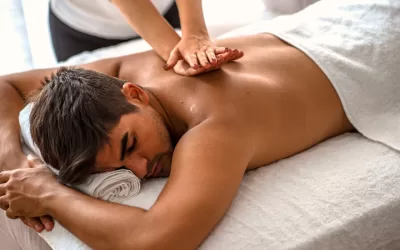Understanding sports injuries and the road to recovery is crucial for athletes and individuals seeking optimal healing. Sports injuries can be caused by overuse, trauma, or poor technique, requiring a combination of rest, rehabilitation, and therapeutic interventions. One such intervention that has gained popularity is therapeutic massage.
Therapeutic massage plays a significant role in promoting healing and reducing pain associated with sports injuries. It improves blood circulation and lymphatic drainage while releasing endorphins that aid in relaxation and pain relief. Athletes with acute or chronic sports injuries can benefit from massage therapy, as well as those undergoing post-surgical rehabilitation. Even recreational sports enthusiasts experiencing muscle soreness or stiffness can find relief through this form of treatment.
If you’re looking to enhance your recovery process and optimize your performance, therapeutic massage may be the solution you’ve been seeking. In this comprehensive guide, we will delve into the benefits of therapeutic massage for sports injuries and help you identify if it’s the right option for you.
The Anatomy Of Sports Injuries
Common Types Of Sports Injuries
Sports injuries can occur in various forms, each with its own set of challenges. Some common types of sports injuries include sprains, strains, fractures, dislocations, and concussions. These injuries often result from sudden impacts or excessive force applied to the body during physical activity. Overuse injuries such as tendinitis and stress fractures are prevalent among athletes who engage in repetitive motions or put excessive strain on certain areas of their bodies.
Understanding the different types of sports injuries is crucial for determining the appropriate treatment approach. Sprains involve the stretching or tearing of ligaments that connect bones together. Strains occur when muscles or tendons are stretched too far or torn. Fractures refer to broken bones resulting from direct impacts or excessive pressure. Dislocations happen when a bone slips out of its normal position within a joint. Lastly, concussions are traumatic brain injuries caused by severe blows to the head.
How Injuries Affect Athletes
Sports injuries can have significant physical, emotional, and psychological effects on athletes. Firstly, these injuries often lead to pain and discomfort, limiting an athlete’s ability to perform at their best. Reduced performance can be frustrating for athletes who strive for excellence in their respective sports.
Moreover, sports injuries may also cause emotional distress and psychological challenges for athletes. The loss of confidence due to an injury can be detrimental to an athlete’s mindset and overall well-being. They may experience anxiety about returning to their sport after recovery or fear reinjuring themselves.
The recovery process itself can also trigger feelings of depression in some athletes. Being unable to participate fully in their chosen sport can lead to a sense of isolation and sadness.
It is important for athletes dealing with sports injuries to receive not only physical treatment but also emotional support throughout the healing process. Therapeutic massage has emerged as a valuable tool in addressing both the physical and emotional aspects of sports injuries. By targeting specific areas of the body, therapeutic massage can help reduce pain, improve circulation, and promote relaxation.
Benefits Of Therapeutic Massage
Improving Circulation And Reducing Inflammation
Therapeutic massage has many benefits. One of the key advantages is its ability to improve circulation and reduce inflammation. By applying targeted pressure and manipulating soft tissues, therapeutic massage helps increase blood flow to injured areas, which aids in tissue repair. It stimulates the lymphatic system, leading to a reduction in inflammation. This increased circulation not only promotes healing but also facilitates the delivery of oxygen and essential nutrients to the affected area.
Alleviating Pain And Enhancing Mobility
Another significant benefit of therapeutic massage for sports injuries is its ability to alleviate pain and enhance mobility. Through various techniques such as kneading, stretching, and deep tissue work, massage therapy effectively reduces muscle tension and trigger points that contribute to discomfort. By addressing these issues, it helps relieve pain associated with sports injuries.
Moreover, therapeutic massage enhances joint mobility by increasing flexibility and range of motion. The manipulation of muscles during a session can help loosen tight muscles around joints, allowing them to move more freely. This improved mobility not only aids in recovery but also prevents future injuries by ensuring proper joint function.
By targeting muscular imbalances caused by overuse or injury, therapeutic massage plays a crucial role in improving overall athletic performance. By addressing these imbalances through specific techniques like myofascial release or neuromuscular therapy, athletes can experience enhanced strength, stability, and coordination.
Accelerating The Recovery Process
One of the most remarkable benefits of therapeutic massage for sports injuries is its ability to accelerate the recovery process. Massage therapy promotes tissue regeneration by increasing blood flow to injured areas. This enhanced circulation brings vital nutrients and oxygen necessary for healing while removing metabolic waste products from the body.
Furthermore, therapeutic massage helps prevent the formation of scar tissue—a common occurrence after an injury—by breaking down adhesions within muscle fibers. This allows for faster and more efficient healing, reducing the risk of long-term complications.
Who Should Consider Therapeutic Massage?
Therapeutic massage is a valuable treatment option for various individuals, depending on their specific needs and circumstances. Let’s explore who can benefit from this form of therapy.
Amateur Athletes And Recreational Sports Enthusiasts
Amateur athletes and recreational sports enthusiasts often engage in physical activities that can lead to minor injuries or muscle soreness. For them, therapeutic massage can play a crucial role in the recovery process. By targeting specific areas of the body, massage therapy helps alleviate pain, reduce inflammation, and promote faster healing. Regular sessions not only aid in the rehabilitation process but also enhance overall well-being and performance. Moreover, incorporating massage into their routine can help prevent future injuries, allowing them to fully enjoy their sports activities.
Professional Athletes With Chronic Pain Or Injuries
Professional athletes face unique challenges due to their demanding training regimens and intense competitions. Those dealing with chronic pain or long-term injuries can find relief through therapeutic massage. This form of therapy complements other treatments they may be receiving, such as physical therapy or chiropractic care. The skilled hands of a massage therapist can help manage pain, reduce inflammation, and improve mobility for optimal performance on the field or court. By incorporating regular massages into their routine, professional athletes can experience enhanced recovery and improved overall well-being.
Individuals Undergoing Post-Surgical Rehabilitation
For individuals undergoing post-surgical rehabilitation, therapeutic massage offers numerous benefits during the recovery process. Massage therapy aids in reducing scar tissue formation while increasing range of motion in affected areas. By improving blood circulation to the injured site, it promotes faster healing and enhances overall rehabilitation outcomes. Therapeutic massage helps alleviate pain associated with surgery by releasing endorphins—natural painkillers produced by our bodies—resulting in a more comfortable recovery journey.
Incorporating therapeutic massage into post-surgical rehabilitation plans allows individuals to regain strength and mobility more efficiently. It is important to consult with a healthcare professional or massage therapist to determine the appropriate timing and techniques for massage therapy after surgery.
Types Of Therapeutic Massage Techniques
1. Deep Tissue Massage
Deep tissue massage is a technique that targets the deeper layers of muscles and connective tissues in the body. It focuses on releasing chronic tension and addressing musculoskeletal issues caused by sports injuries. Although deep tissue massage may cause temporary discomfort, it provides long-lasting relief by targeting specific problem areas.
2. Swedish Massage
Swedish massage is a popular technique that uses long, flowing strokes to promote relaxation and improve circulation throughout the body. It is beneficial for reducing muscle tension, relieving stress, and enhancing overall well-being. With its versatility, Swedish massage can be customized to address specific areas affected by sports injuries, such as tight hamstrings or a strained shoulder.
3. Sports Massage
Sports massage is specifically designed to prevent and treat sports-related injuries. This technique combines various modalities like stretching, compression, and deep tissue massage to cater to the unique needs of athletes. Sports massage helps athletes prepare for intense physical activity by improving flexibility and range of motion. It aids in post-activity recovery by reducing muscle soreness and promoting faster healing.
These different techniques play an essential role in providing targeted relief and aiding in recovery. Deep tissue massage works on releasing tension deep within the muscles, while Swedish massage focuses on relaxation and improving circulation throughout the body. Sports massage combines various techniques to address specific athletic needs before or after intense physical activity.
When To Seek Therapeutic Massage
Massage therapy can be a valuable tool for athletes dealing with sports injuries. But when is the right time to consider therapeutic massage? Let’s explore three key points that highlight when seeking therapeutic massage can be beneficial.
During The Acute Phase Of Injury
During the acute phase of injury, therapeutic massage focuses on reducing pain and inflammation. By using gentle techniques like effleurage (long, sweeping strokes) and lymphatic drainage, therapists aim to promote healing without causing further damage. These techniques help improve blood circulation and reduce swelling in the injured area. It’s crucial for therapists to avoid applying excessive pressure during this phase to prevent additional harm.
Throughout The Rehabilitation Process
Therapeutic massage remains beneficial throughout the rehabilitation process as it aids in recovery. Techniques such as myofascial release (gentle stretching of the connective tissue) and cross-fiber friction can address scar tissue formation and muscle imbalances caused by injury or prolonged immobilization. Regular sessions help maintain flexibility, prevent re-injury, and support overall rehabilitation progress by improving range of motion and promoting proper muscular function.
As Preventative Care To Avoid Future Injuries
Regular therapeutic massage sessions can also serve as preventative care to avoid future sports injuries. Massage therapy helps improve muscular balance, flexibility, and range of motion, reducing the risk of strains or sprains during physical activity. It enhances body awareness among athletes, allowing them to identify potential issues before they become serious injuries. By addressing minor imbalances or discomfort early on through regular sessions, athletes can take proactive measures to maintain their physical well-being.
Integrating Massage With Other Treatments
Physical Therapy And Exercise
Combining massage therapy with physical therapy exercises is a powerful approach to optimizing rehabilitation outcomes. When used together, these therapies work hand in hand to promote healing and recovery. Before engaging in exercise, therapeutic massage helps prepare muscles by increasing blood flow and flexibility. This allows for better performance during workouts and reduces the risk of further injury. After exercise, massage aids in post-workout recovery by reducing muscle soreness and promoting relaxation. The integration of both approaches promotes strength, flexibility, and overall functional improvement.
Nutritional Guidance For Optimal Healing
Proper nutrition plays a crucial role in sports injury recovery. In addition to providing hands-on treatment, massage therapists can also offer guidance on dietary choices that support healing and reduce inflammation. They can provide recommendations on incorporating foods rich in essential nutrients into one’s diet to support tissue repair and overall wellness. By maintaining a well-balanced diet that includes vitamins, minerals, proteins, carbohydrates, and healthy fats, individuals can aid their bodies’ natural healing processes.
Stress Reduction And Mental Health Support
Sports injuries not only take a toll on the body but also impact mental health. Therapeutic massage offers benefits beyond physical healing by reducing stress levels and promoting relaxation. Through the manipulation of soft tissues, it stimulates the release of endorphins – natural feel-good chemicals in the body that help alleviate stress and improve mood. This form of therapy provides emotional support during the challenging recovery process as well. It offers individuals an opportunity to relax both physically and mentally while receiving care from a trained professional who understands their unique needs.
Furthermore, research has shown that therapeutic massage can have positive effects on mental health by reducing anxiety and depression symptoms. Regular sessions have been found to decrease anxiety levels significantly while improving sleep quality among individuals dealing with sports-related injuries or other sources of stress.
Choosing The Right Massage Therapist
Credentials And Specializations To Look For
When considering therapeutic massage for sports injuries, it is crucial to choose a massage therapist who possesses the necessary credentials and specializations. Look for licensed massage therapists or certified sports massage therapists. These qualifications ensure that the therapist has undergone proper training and education in the field of massage therapy. Seek out therapists who specialize in sports massage, deep tissue techniques, or injury rehabilitation. These specialized skills can aid in effectively treating sports-related injuries by targeting specific areas of concern.
Understanding Your Needs And Goals
To achieve optimal results from therapeutic massage for sports injuries, effective communication with your therapist is key. It is important to clearly articulate your specific needs and goals during your sessions. Discuss the nature of your injury, including any pain levels or limitations you may be experiencing. By providing this information, your therapist can tailor their approach to address your individual circumstances. This personalized treatment plan will help maximize the benefits of therapeutic massage for your sports injury recovery.
Finding A Therapist Who Understands Sports Injuries
When seeking a therapist for sports injury recovery, it is essential to find someone who has experience working with athletes and understands the intricacies of sports-related injuries. One way to find such a therapist is by seeking recommendations from coaches, trainers, or fellow athletes who have utilized therapeutic massage services in the past. Their firsthand experiences can provide valuable insights into finding a skilled professional who specializes in treating sports injuries.
In addition to recommendations, conducting thorough research on potential therapists is crucial. Take the time to review their backgrounds and qualifications to ensure they possess the necessary expertise required for effectively addressing sports-related injuries through therapeutic massage techniques. Reading reviews from previous clients can also offer valuable perspectives on their experiences with specific therapists.
By choosing a qualified and experienced therapist who understands sports injuries, you are setting yourself up for an effective recovery process. Their knowledge of athletic performance and common injuries in sports will enable them to tailor their techniques and treatments to your specific needs. This targeted approach can help alleviate pain, reduce inflammation, improve flexibility, and enhance overall recovery.
Remember, therapeutic massage for sports injuries is a collaborative process between you and your therapist. Open communication, clear goals, and finding the right professional are all essential steps towards achieving optimal results in your recovery journey.
Preparing For Your Therapeutic Massage Session
What To Expect During Treatment
During your therapeutic massage session, you can expect to enter a comfortable environment that promotes relaxation and healing. The therapist will tailor their techniques based on your specific needs and preferences, ensuring a personalized experience. Whether you require deep tissue work or gentle strokes, the therapist will adapt their approach accordingly. It is crucial to communicate with the therapist throughout the session, expressing any concerns or discomfort you may feel. This open line of communication allows them to adjust the pressure and technique as needed, ensuring your comfort and satisfaction.
Post-Massage Care And Follow-up
After your therapeutic massage session, it is essential to follow any post-massage care instructions provided by the therapist. These instructions may include recommendations for stretching exercises or self-care practices that can enhance the benefits of the massage. Staying hydrated is crucial after a massage as it aids in flushing out toxins released during the treatment.
To maintain progress and prevent future injuries, scheduling regular follow-up sessions is highly recommended. Consistency plays a significant role in reaping the full benefits of therapeutic massage. By continuing with regular appointments, you allow your body to build upon previous treatments and facilitate long-term healing.
Conclusion
In conclusion, therapeutic massage is a valuable treatment option for individuals dealing with sports injuries. The benefits of therapeutic massage, such as pain relief, improved flexibility, and reduced inflammation, make it an effective complementary therapy in the rehabilitation process. Athletes, both professional and amateur, can greatly benefit from incorporating therapeutic massage into their recovery plan.
To make the most of therapeutic massage for sports injuries, it is crucial to choose a qualified and experienced massage therapist who understands the specific needs of athletes. Integrating massage with other treatments like physical therapy or chiropractic care can enhance the overall healing process. It is important to note that therapeutic massage should be sought at the appropriate time during the injury recovery timeline.
If you are an athlete or someone dealing with a sports injury, consider exploring the potential benefits of therapeutic massage. Consult with a healthcare professional or a licensed massage therapist to determine if this treatment modality is suitable for your specific condition. By taking proactive steps in your recovery journey, you can optimize your chances of returning to peak performance and achieving long-term well-being.
Harnessing The Power Of Therapeutic Massage For Sports Injuries: Your Path To Recovery!
Are you struggling with the aftermath of a sports injury, feeling hampered by pain and limited mobility? Turn to the experts at MedicinEvolution, where the healing touch of Therapeutic Massage is expertly applied to target your sports-related injuries, offering a path to effective recovery! Wave goodbye to the discomfort caused by strained muscles, overexertion, and repetitive sports movements—as MedicinEvolution taps into the root causes of your injury, facilitating a transformative healing process. With their skilled approach, you’ll experience a remarkable turnaround from the pain that once hindered your athletic performance!
Whether you’re grappling with persistent pain, stiffness, or the frustrating limitations of a sports injury, their specialized methods are designed to meet the specific needs of your condition. Don’t let injury setbacks control your athletic journey—take the reins and schedule your session with MedicinEvolution today! Step into the realm of Therapeutic Massage and embark on a road to a more active, pain-free life. Your body—and your athletic aspirations—will be grateful!





